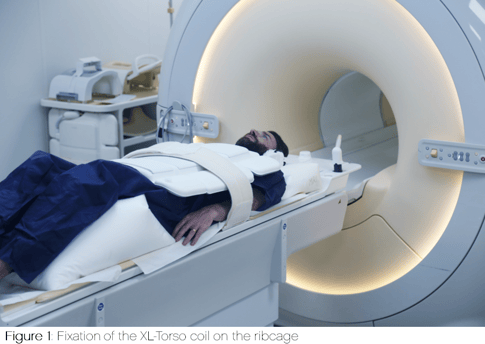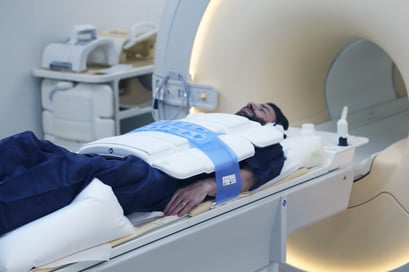The rising number of examinations coupled with increased demands are putting more and more pressure on the radiology department. Aspects such as easy handling, impeccable hygiene and the influence on patient comfort are therefore much more important than ever before.
For this reason, it is very important to use hygienically impeccable products that can be disinfected quickly and easily after each examination. An example of this are fixation straps or belts that are often used at the MRI and are almost indispensable for fixing torso coils.
As part of a project to further optimise workflows at the MRI, Michaela Reichelt, lead radiographer, critically observed the use of fixation straps and evaluated an alternative solution.
Challenges

The project was carried out on a Philips Achieva 3T, which can be used to cover all common MRI examinations. The fixation straps, which are provided by the manufacturers as standard, are available in different versions and are used several times a day:
- Long hook-and-loop strap on XL torso coil (figure 1)
- Long hook-and-loop strap as a wrap
During the analysis, it turned out that the process of attaching the XL torso coil requires numerous steps and can take several minutes. Due to the soft, fabric-like surfaces, the fixation straps keep slipping, which can lead to suboptimal positioning of the coil and thus slows down the workflow.
Another challenge associated with the fixation straps is the hygiene concept, which requires that the straps are washed in the washing machine after each examination. Accordingly a large number of identical straps are needed and the wear and tear is relatively high.
Solution
Because of the above-mentioned disadvantages of the fixation belts, it was decided to evaluate alternative solutions. The so-called ProBelt system was chosen. These belts are made of a durable, slightly elastic and only 0.4 mm thin polyurethane foil. In contrast to conventional fixation belts, the ProBelt is completely hook-and-loop-free and can be adjusted almost infinitely to the desired circumference by means of a simple button-hole-system.
In order to compare the conventional fixation belts with the ProBelt, the ProBelt was tested over a period of three months with regard to various criteria, achieving remarkable results in terms of hygiene, user-friendliness and patient comfort.
.
Conclusion

With the ProBelt system optimised for the Philips MRI, various improvements have been achieved. Workflows have been simplified and accelerated, hygiene requirements are fully complied with and patient feedback has been consistently positive. Due to the positive experiences, the ProBelt was adopted into standard patient operation after only a short three-month trial period and is now in regular use.

